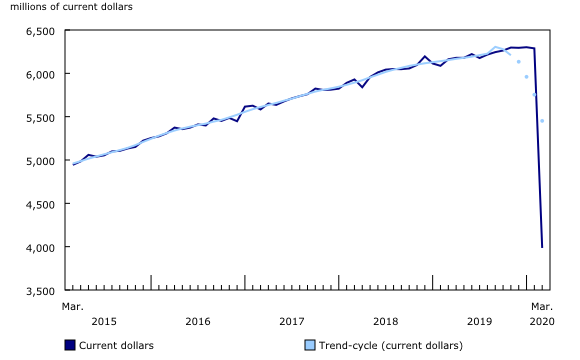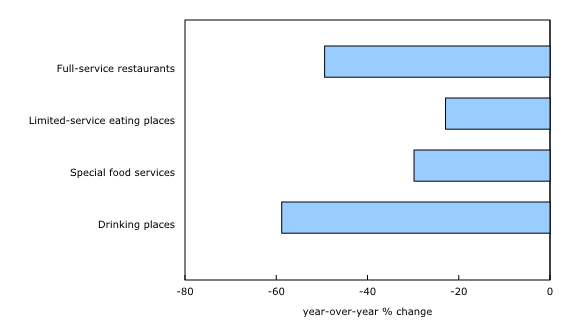Food services and drinking places, March 2020
Archived Content
Information identified as archived is provided for reference, research or recordkeeping purposes. It is not subject to the Government of Canada Web Standards and has not been altered or updated since it was archived. Please "contact us" to request a format other than those available.
Released: 2020-05-26
$4.0 billion
March 2020
-36.6% 
(monthly change)
$47.3 million
March 2020
-34.1% 
(monthly change)
$17.3 million
March 2020
-33.0% 
(monthly change)
$98.2 million
March 2020
-32.2% 
(monthly change)
$71.0 million
March 2020
-32.6% 
(monthly change)
$744.6 million
March 2020
-39.6% 
(monthly change)
$1,578.4 million
March 2020
-36.9% 
(monthly change)
$125.4 million
March 2020
-30.4% 
(monthly change)
$109.1 million
March 2020
-32.0% 
(monthly change)
$527.9 million
March 2020
-34.3% 
(monthly change)
$655.3 million
March 2020
-37.6% 
(monthly change)
$5.0 million
March 2020
-29.5% 
(monthly change)
$4.3 million
March 2020
-31.9% 
(monthly change)
$1.3 million
March 2020
-15.5% 
(monthly change)
Sales in the food services and drinking places subsector fell 36.6% (seasonally adjusted) to $4.0 billion in March 2020, with businesses across the country closing because of COVID-19 regulations. This is the largest decline since the beginning of the series in 1998. Lower sales were reported across all industry groups and in all provinces and territories.
Further information can be found in the "Food Services and Drinking Places Sales" dashboard. This web application provides access to data on sales in food services and drinking places for Canada, and by province and territory. This dynamic application allows users to compare provincial and territorial data through interactive maps and charts.
COVID-19
In March, a series of unprecedented government interventions related to COVID-19 were put in place, including the closure of non-essential businesses, travel restrictions, and public health measures directing Canadians to limit public interactions. During the reference period, all provinces restricted access to businesses in the restaurant industry and implemented closures.
Restaurant dining rooms were closed across the country, and take-out and delivery became the only available options. Prior to the pandemic, Quebec was the only province to allow restaurants to sell alcohol with take-out meals. To ease pressures on the industry, most provinces permitted restaurants to sell alcohol for take-out by the end of March, but this did little to maintain sales at their usual levels. Restrictions and closures affecting the food services and drinking places subsector continued into subsequent months.
Sales fall as COVID-19 restrictions affect each industry group differently
The largest declines in dollar terms were reported at full-service restaurants (-48.6%), followed by limited-service eating places (-23.8%), special food services (-33.8%) and drinking places (-55.8%).
Full-service restaurants saw a large decline in March (-48.6%). While provinces ordered the closure of dining rooms by the end of March, restrictions limited the number of diners even before the closures were mandated. Some restaurants voluntarily closed their dining rooms before restrictions were put in place as customers stopped going to restaurants even if they were still open. Alcohol sales, representing approximately 20% of total sales, declined as dining rooms closed. Most provinces allowed restaurants to provide alcohol with take-out and delivery food orders in the second half of the month. At the same time, sales increased at supermarkets and other grocery stores (+27.1%) and beer, wine and liquor stores (+17.5%).
Limited-service eating places saw the smallest drop in sales in percentage terms (-23.8%), with sales buoyed by take-out and delivery. Sales decreased as dining rooms closed, as well as stalls in shopping malls.
Sales of special food services, particularly food service contractors and caterers, fell 33.8% as school and business closures rendered cafeterias unnecessary and flight cancellations reduced sales of inflight meals and at airport food stalls. Food service contractors working in stadiums closed as sporting events were suspended and concerts cancelled. Limits on public gatherings affected events such as weddings, funerals and conferences, with many caterers' contracts being cancelled.
Drinking places saw the largest decline in percentage terms (-55.8%) as gatherings of more than 50 people were prohibited. This meant that nightclubs and bars closed before restaurants had to. Many do not have take-out options. St. Patrick's Day, typically one of the busiest nights of the year, was cancelled in many drinking places across the country.
Sales decline in each province
All provinces and territories reported lower sales in March 2020 amid the COVID-19 pandemic and the resulting restrictions and closures in the food services and drinking places subsector. Ontario (-36.9%), Quebec (-39.6%) and British Columbia (-37.6%) reported the largest declines in dollar terms.
In Ontario, the provincial government declared a state of emergency on March 17 and ordered the closure of restaurants and bars, excluding take-out and delivery.
Quebec had the largest decline in percentage terms (-39.6%) as it was the first province to impose restrictions. On March 15, the Quebec government closed all bars and asked restaurants to limit seating capacity to 50% of their maximum. On March 23, all non-essential services, including restaurant dining rooms, were closed.
British Columbia had one of the largest declines (-37.6%) as it was one of the first provinces to impose restrictions on gatherings of 50 people or more (March 16), including in food services and drinking places. On March 18, bars, pubs and nightclubs were ordered to close. These were followed on March 20 by restaurants and cafes, which were then only able to offer take-out and delivery.
Manitoba saw the smallest decline in sales in percentage terms (-30.4%) as it imposed restrictions later than other provinces. As of March 20, restaurants had to limit occupancy to 50 people or 50% of maximum capacity, whichever was lower. On March 30, gatherings of more than 10 people were prohibited, a measure that applied to events such as weddings and funerals. Other restrictions did not come into effect until April 1.
Year-over-year sales decrease
The figures in this section are based on unadjusted (that is, not seasonally adjusted) estimates.
Because of the effects of COVID-19 on the food services and drinking places subsector, unadjusted sales for March 2020 were down 36.6% compared with March 2019. Sales decreased in each of the following industry groups: full-service restaurants (-49.4%), limited-service eating places (-22.9%), special food services (-29.8%) and drinking places (-58.8%).
Year-over-year sales decreased in each province by roughly one-third, with Ontario (-36.7%), Quebec (-38.6%) and British Columbia (-38.3%) contributing to three-quarters of the total national decrease.
Prices for food purchased from restaurants were up 1.8% in March 2020 compared with March 2019, and prices for alcoholic beverages served in licensed establishments increased 1.9% in the same period.
Note to readers
All data in this release are seasonally adjusted and are expressed in current dollars, unless otherwise noted. Seasonally adjusted data are data that have been modified to eliminate the effect of seasonal and calendar influences to allow for more meaningful comparisons of economic conditions from period to period. For more information on seasonal adjustment, see Seasonally adjusted data – Frequently asked questions.
Trend-cycle data are included in selected charts as a complement to the seasonally adjusted series. These data represent a smoothed version of the seasonally adjusted time series and provide information on longer-term movements, including changes in direction underlying the series. For information on trend-cycle data, see the StatCan Blog and Trend-cycle estimates – Frequently asked questions.
Data for the current reference month are preliminary. Usually, unadjusted data are revised for the previous two months, and seasonally adjusted data are revised for the previous three months. Both seasonally adjusted data and trend-cycle estimates are subject to revision as additional observations become available. These revisions could be large and could even lead to a reversal of movement, especially for reference months near the end of the series or during periods of economic disruption.
Contact information
For more information, or to enquire about the concepts, methods or data quality of this release, contact us (toll-free 1-800-263-1136; 514-283-8300; STATCAN.infostats-infostats.STATCAN@canada.ca) or Media Relations (613-951-4636; STATCAN.mediahotline-ligneinfomedias.STATCAN@canada.ca).
- Date modified:



